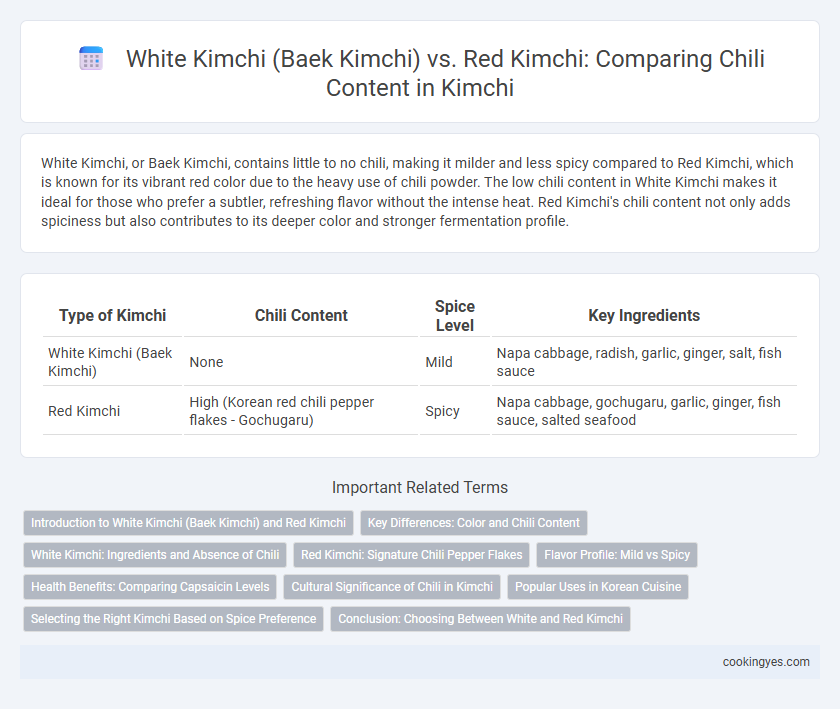White Kimchi, or Baek Kimchi, contains little to no chili, making it milder and less spicy compared to Red Kimchi, which is known for its vibrant red color due to the heavy use of chili powder. The low chili content in White Kimchi makes it ideal for those who prefer a subtler, refreshing flavor without the intense heat. Red Kimchi's chili content not only adds spiciness but also contributes to its deeper color and stronger fermentation profile.
Table of Comparison
| Type of Kimchi | Chili Content | Spice Level | Key Ingredients |
|---|---|---|---|
| White Kimchi (Baek Kimchi) | None | Mild | Napa cabbage, radish, garlic, ginger, salt, fish sauce |
| Red Kimchi | High (Korean red chili pepper flakes - Gochugaru) | Spicy | Napa cabbage, gochugaru, garlic, ginger, fish sauce, salted seafood |
Introduction to White Kimchi (Baek Kimchi) and Red Kimchi
White Kimchi (Baek Kimchi) contains little to no chili, making it a milder, non-spicy variant, while Red Kimchi is traditionally spicy due to the generous use of red chili pepper flakes (gochugaru). Baek Kimchi emphasizes a refreshing, clean taste created from ingredients like napa cabbage, garlic, and ginger, without the heat of chili. Red Kimchi's iconic red color and fiery flavor come from fermenting napa cabbage with gochugaru, garlic, and fermented fish sauce, offering a bold and spicy profile.
Key Differences: Color and Chili Content
White Kimchi (Baek Kimchi) is characterized by its pale, milky color due to the absence of red chili pepper powder, resulting in a mild, less spicy flavor. In contrast, Red Kimchi contains significant amounts of red chili pepper powder, giving it a vibrant red hue and a pronounced spicy heat. The chili content directly influences the color and heat level, making White Kimchi suitable for those preferring a milder taste, while Red Kimchi appeals to spice enthusiasts.
White Kimchi: Ingredients and Absence of Chili
White Kimchi, or Baek Kimchi, is characterized by its absence of red chili powder, differentiating it from the spicy Red Kimchi. It primarily includes Napa cabbage, Korean radish, garlic, ginger, and salted shrimp, creating a mild, refreshing flavor profile without heat. The omission of chili powder makes White Kimchi suitable for those sensitive to spiciness while preserving the probiotic benefits of fermented vegetables.
Red Kimchi: Signature Chili Pepper Flakes
Red Kimchi, known for its signature chili pepper flakes called gochugaru, contains significantly higher levels of capsaicin compared to White Kimchi (Baek Kimchi), which lacks these spicy flakes. The vibrant red color of Red Kimchi is derived from fermented chili powder that not only contributes to its heat but also enhances its antioxidant properties. In contrast, White Kimchi offers a milder, non-spicy flavor profile, making Red Kimchi the preferred choice for those seeking a robust, spicy kick in traditional Korean cuisine.
Flavor Profile: Mild vs Spicy
White Kimchi (Baek Kimchi) contains little to no chili, resulting in a mild, refreshing flavor with hints of garlic, ginger, and napa cabbage. In contrast, Red Kimchi is packed with gochugaru (Korean red chili powder), delivering a pronounced spiciness that balances heat with umami-rich fermented flavors. The chili content significantly influences the overall taste experience, with White Kimchi emphasizing subtle, clean notes and Red Kimchi offering a robust, fiery kick.
Health Benefits: Comparing Capsaicin Levels
White Kimchi (Baek Kimchi) contains little to no chili peppers, resulting in minimal capsaicin content, which reduces spiciness and potential digestive discomfort. Red Kimchi is rich in red chili pepper powder, providing higher capsaicin levels that contribute to metabolism boosting and anti-inflammatory properties. Capsaicin in red kimchi supports cardiovascular health and pain relief, while white kimchi offers gentle probiotic benefits without heat.
Cultural Significance of Chili in Kimchi
White Kimchi (Baek Kimchi) contains little to no chili, highlighting its milder, refreshing taste ideal for summer months, whereas Red Kimchi is rich in chili, symbolizing the fiery spirit and robust flavors central to Korean cuisine. Chili peppers, introduced to Korea in the 16th century, revolutionized kimchi's flavor profile and became a cultural icon representing vitality and warmth in Korean food culture. The varying chili content between White and Red Kimchi reflects regional preferences and historical consumption patterns, underscoring chili's pivotal role in Korean culinary identity.
Popular Uses in Korean Cuisine
White Kimchi (Baek Kimchi) contains little to no chili peppers, making it mild and suitable for those sensitive to spicy foods, often used in soups and as a refreshing side dish. Red Kimchi, rich in chili powder and flakes, delivers a bold, spicy flavor essential in dishes like kimchi jjigae and stir-fries, providing heat and depth. Both types are integral to Korean cuisine, with White Kimchi favored for cooling balance and Red Kimchi prized for its vibrant spice.
Selecting the Right Kimchi Based on Spice Preference
White Kimchi (Baek Kimchi) contains little to no chili, making it ideal for those who prefer a mild, non-spicy flavor profile. Red Kimchi, infused with red chili pepper powder (gochugaru), offers a spicy, bold taste suitable for heat enthusiasts. Choosing between White and Red Kimchi depends primarily on individual tolerance for spice and desired culinary intensity.
Conclusion: Choosing Between White and Red Kimchi
White kimchi (Baek kimchi) contains little to no chili, making it mild and suitable for those sensitive to spice or seeking a refreshing flavor. Red kimchi is rich in chili peppers, delivering a spicy, robust taste favored by spice enthusiasts and those wanting a bolder kick. Choosing between white and red kimchi depends on personal preference for heat level and desired flavor profile, with white kimchi offering a gentle taste and red kimchi providing a spicy experience.
White Kimchi (Baek Kimchi) vs Red Kimchi for Chili Content Infographic

 cookingyes.com
cookingyes.com